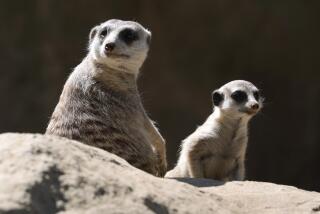Animal encounters in the green glades of Happy Hollow Park and Zoo in San Jose
- Share via
reporting from San Jose — Since the Happy Hollow Park and Zoo in San Jose completed a $72-million renovation in March, it’s attracted a new set of visitors besides all those tykes and toddlers in high-tops and jeans.
Because of the renovation, the zoo was awarded the Leadership in Energy and Environmental Design (LEED) Gold certificate — the first in the nation for a zoo or amusement park — by the nonprofit U.S. Green Building Council.
Kids who crowd Happy Hollow to see pygmy goats and ring-tailed lemurs must share the zoo with tree-hugging environmentalists who show up to check out the latest in green building designs.
“We have tapped into a new audience,” said Shannon Heimer, the zoo’s education manager.
Frisky capuchin monkeys and sleek jaguars are enough to draw me to any zoo, but I was interested to see what it took to win Happy Hollow a top distinction from the nation’s leading environmental design panel.
Visitors interested in the Gold award-winning features can take a self-guided tour of the “green” improvements. For larger groups, the zoo’s education department will lead personalized tours if requested in advance.
THE BEST WAY TO SAN JOSE
From LAX, American, Southwest, Alaska and United offer nonstop flights to San Jose. Restricted round-trip fares begin at $178.
Happy Hollow Park and Zoo, 1300 Senter Road, San Jose; (408) 794-6400, https://www.hhpz.org. Admission $12 for ages 2 to 69; $8 for ages 70 and older. Hours vary; check website for information. The city-run facility is an orderly arrangement of cages, corrals and pens on 16 acres of hilly land. Other attractions, popular with those ages 7 and younger, are the carousel, tree house, several carnival rides and a puppet theater.
The zoo also hosts regular conservation lectures in the Learning Lodge, a small single-story building that uses hay bales, stuffed into the walls, for insulation. The zoo also heats and cools the building by pumping hot or cold water through pipes in the floor. The radiant flooring can cut energy costs as much as 30% over forced-air heating.
The first thing that caught my attention after I entered the zoo was the grass sprouting from the roofs of seven zoo buildings. The grass is meant to keep the buildings cool in the summer and warm in the winter and can reduce storm-water runoff by as much as 90%.
Crushed glass, recycled from old bottles, paves the zoo’s colorful entryway. Beneath the zoo’s walkways, rainwater and runoff flows through channels into an underground catch basin.
Even the “Danny the Dragon” attraction, which pulls passengers along a concrete path, has been overhauled and its gasoline engine replaced with an electric motor.
Except for the grass-sprouting roofs, most of the environmental features blend into the zoo’s scenery. For example, the “spiral lawn,” a patch of grass near the carousel, resembles a whimsically landscaped play area. Coiled rows of grass create a swirling channel that sends runoff into an underground basin.
While admiring the “spiral lawn,” I bumped into Spencer Supinger, a civil engineer from Merced, Calif., who came to the zoo with his wife and 2-year-old daughter. Supinger’s little girl was sprinting around the spiral lawn while he was admiring how the zoo disguised something as basic as a drainage ditch.
“As an engineer, I like how they used the lawn to move the water into the basin,” he said, motioning to the spiral.
The animals benefit from living in an LEED Gold-certified zoo too, because the fruits and vegetables they eat are grown on the park grounds instead of being shipped from a wholesale grocer.
The birds, goats and horses love the peaches, tomatoes, peppers and squash that sprout on the zoo property, said senior zookeeper Jena Sorrells.
“They get lots of fresh fruits and veggies every day,” she said as she cleaned out a corral. The zoo and park produce so much food that employees take home extras. Sorrells boasted about making caramel apples with the Granny Smith apples grown at the zoo.
But the fruit trees, hay-bale insulation, water-collection system and rubber playground padding, made of recycled tires, are just a sideshow at the zoo.
Tammi Tuyor, a mother of two from San Ramon, Calif., considers herself an environmentalist but didn’t bring her kids to the zoo for its green design features.
“It doesn’t make a difference to me if they do these things or not,” she said, watching her children race to the petting zoo to feed the pygmy goats. “It’s nice that they have these things, but I come because my kids love it here.”
More to Read
Sign up for The Wild
We’ll help you find the best places to hike, bike and run, as well as the perfect silent spots for meditation and yoga.
You may occasionally receive promotional content from the Los Angeles Times.






